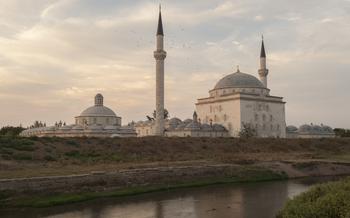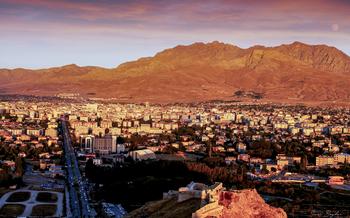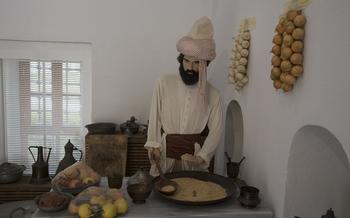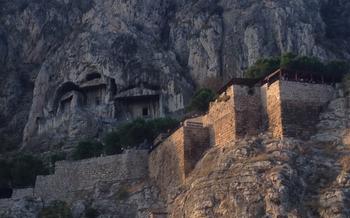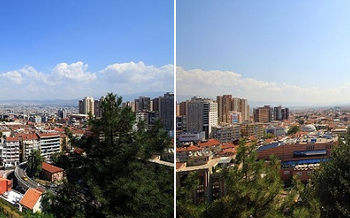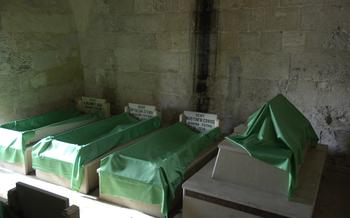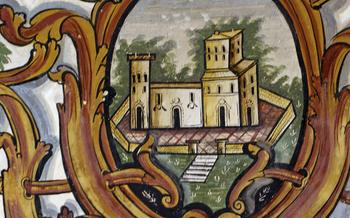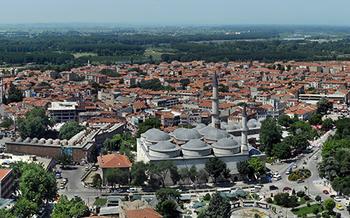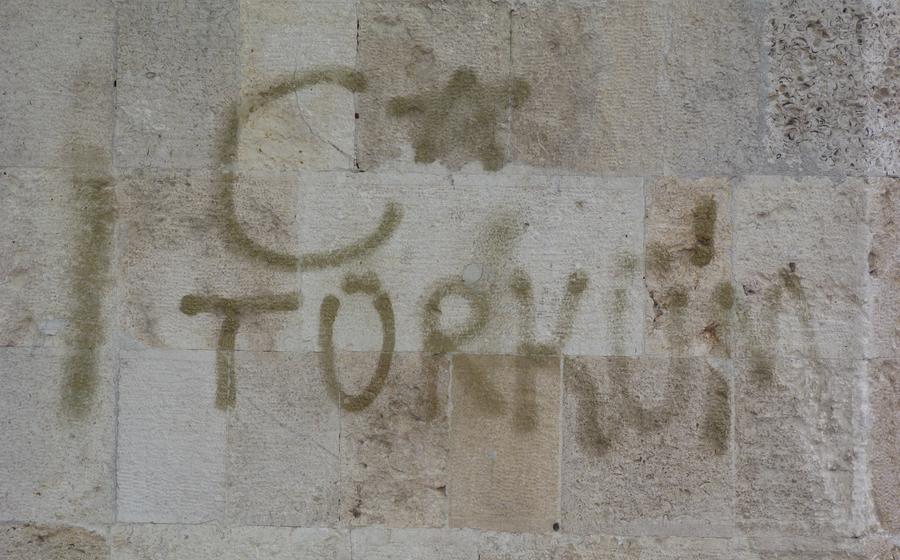
İkinci Beyazıt Külliyesi Social Complex
- A Masterpiece of Ottoman Architecture:
- The Grand Mosque:
- The Imaret
- The Darüşşifa (Hospital)
- The Medrese (Theological School)
- The Turkish Bath
- The Caravanserai
- The Clock Tower:
- The Museum
- The Gardens
- Local Cuisine
- Festivals and Events
- Accommodation Options
A Masterpiece of Ottoman Architecture:
The İkinci Beyazıt Külliyesi stands as a testament to the grandeur and architectural prowess of the Ottoman Empire. Built during the reign of Sultan Bayezid II between 1484 and 1488, the külliye is an intricate complex that encompasses a mosque, an imaret (soup kitchen), a darüşşifa (hospital), a medrese (theological school), a Turkish bath, a caravanserai (inn), a clock tower, and a museum. Situated in the heart of Edirne, the former Ottoman capital, the külliye reflects the city's rich history and cultural heritage. Its strategic location on the banks of the Tunca River and along the historic Silk Road further solidified Edirne's significance as a center of trade, learning, and cultural exchange.
Beyond its architectural beauty, the İkinci Beyazıt Külliyesi played a crucial role in Ottoman urban planning and social welfare. The complex provided essential services to the local community, such as education, healthcare, and food distribution, embodying the empire's commitment to social justice and public welfare. The külliye's construction also stimulated economic activity and created employment opportunities, contributing to the overall prosperity and development of Edirne.
As a symbol of the power and prosperity of the Ottoman Empire, the İkinci Beyazıt Külliyesi stands as a testament to the empire's architectural achievements and its commitment to providing for the well-being of its citizens. Its enduring legacy continues to inspire awe and admiration, attracting visitors from around the world to marvel at its grandeur and historical significance.
Anecdote:
According to legend, during the construction of the külliye, Sultan Bayezid II visited the site and noticed that the foundations were not as deep as he had ordered. He immediately summoned the architect and expressed his displeasure. The architect, fearing for his life, explained that the soil was too soft to support deeper foundations. Bayezid, known for his wisdom and justice, ordered the architect to fill the foundations with honey and then water. The honey solidified the soil, creating a solid base for the külliye to stand upon, and the architect was spared from punishment. This story highlights Sultan Bayezid II's attention to detail, his commitment to quality, and his willingness to listen to the advice of his experts.
The Grand Mosque:
The Grand Mosque, the heart of the İkinci Beyazıt Külliyesi, stands as a testament to the architectural prowess of the Ottoman Empire. Its imposing dome, soaring minarets, and serene courtyard create a sense of awe and tranquility. The mosque's interior is equally captivating, adorned with intricate tilework, elegant calligraphy, and a magnificent mihrab that serves as the focal point for prayer. The minbar, or pulpit, is a masterpiece of craftsmanship, featuring intricate carvings and inlaid mother-of-pearl.
Beyond its architectural splendor, the Grand Mosque holds immense historical significance. It served as a place of worship and learning for centuries, hosting religious ceremonies, Quranic recitals, and scholarly discussions. The mosque's association with the Ottoman dynasty further adds to its importance, as it was frequently visited by sultans and high-ranking officials for prayers and special occasions.
Personal Anecdote:
During my visit to the Grand Mosque, I was fortunate enough to witness a moving prayer ceremony. The mosque's spacious courtyard was filled with rows of devout worshippers, their voices rising in unison as they recited verses from the Quran. The atmosphere was electrifying, and I couldn't help but feel a sense of peace and spirituality wash over me. It was a truly memorable experience that left a lasting impression on my heart.
The Imaret
The imaret, or soup kitchen, is a crucial component of the İkinci Beyazıt Külliyesi, embodying the Ottoman Empire's commitment to social welfare and charitable deeds. This benevolent institution served as a lifeline for the needy, providing sustenance and nourishment to those in dire straits.
Architecturally, the imaret is a marvel of design, featuring a spacious kitchen equipped with large cauldrons and ovens for preparing vast quantities of food. The dining hall, with its long rows of tables and benches, could accommodate hundreds of people at a time. Storage areas were meticulously organized to ensure a steady supply of ingredients and provisions.
During the Ottoman period, the imaret played a pivotal role in alleviating hunger and poverty. It operated on a daily basis, distributing meals to the poor, the sick, and travelers who sought refuge within the külliye's walls. This charitable practice, rooted in Islamic principles, reflected the Ottoman Empire's deep-seated commitment to social justice and compassion.
A poignant story associated with the imaret speaks to its transformative impact on the lives of those it served. In the 16th century, a young orphan named Ahmet found himself destitute and alone on the streets of Edirne. Desperation led him to the imaret, where he was welcomed with open arms. The nourishing meals and the kindness shown to him by the imaret's staff gave Ahmet a renewed sense of hope and purpose. With the support of the külliye, he was able to receive an education and eventually became a successful merchant, using his wealth to help others in need, perpetuating the cycle of compassion that had once saved him.
The Darüşşifa (Hospital)
The darüşşifa, or hospital, within the İkinci Beyazıt Külliyesi was a pioneering institution in Ottoman healthcare. Established to provide medical care and treatment to the sick and injured, the darüşşifa played a crucial role in the welfare of the community.
Architecturally, the darüşşifa featured specialized wards, treatment rooms, and a pharmacy, reflecting its commitment to comprehensive medical care. Its design prioritized hygiene and sanitation, with separate areas for different ailments and a dedicated water system for cleanliness.
Beyond its physical structure, the darüşşifa was staffed with skilled physicians and healers who provided compassionate care to patients from all walks of life. They practiced a holistic approach to medicine, combining traditional Islamic medical knowledge with contemporary medical advancements.
Historical accounts narrate the remarkable stories of patients who received exceptional care at the darüşşifa. One such story tells of a young woman who arrived at the hospital with a severe illness. The physicians diagnosed her with a rare condition and provided her with specialized treatment, ultimately leading to her recovery.
The darüşşifa's legacy extends far beyond its time, as it served as a model for future hospitals in the Ottoman Empire and beyond. Its dedication to providing quality healthcare to those in need exemplified the compassionate and humanitarian spirit of the Ottoman society.
The Medrese (Theological School)
The medrese, or theological school, within the İkinci Beyazıt Külliyesi stands as a testament to the Ottoman Empire's commitment to Islamic learning and scholarship. Constructed during the reign of Sultan Beyazıt II in the 15th century, the medrese served as a prominent center for the study of Islamic law, theology, and other religious sciences.
Architecturally, the medrese showcases a traditional Ottoman design, featuring a central courtyard surrounded by classrooms, a library, and student dormitories. The classrooms, known as dershane, were designed to accommodate small groups of students gathered around their teacher, fostering a close and interactive learning environment.
The curriculum at the medrese was rigorous and comprehensive, covering a wide range of Islamic subjects, including tafsir (Qur'anic exegesis), hadith (prophetic traditions), fiqh (Islamic jurisprudence), and kalam (Islamic theology). Students who successfully completed the program of study were awarded ijazas, or certificates of completion, which recognized their mastery of Islamic knowledge.
Over the centuries, the medrese produced numerous renowned scholars and graduates who went on to hold influential positions in the Ottoman religious and intellectual landscape. Among the most notable figures associated with the medrese was Ebussuud Efendi, who served as the chief Ottoman mufti, or religious authority, during the reign of Sultan Süleyman the Magnificent.
Today, the medrese within the İkinci Beyazıt Külliyesi serves as a reminder of the Ottoman Empire's rich tradition of Islamic scholarship and its enduring legacy in shaping the intellectual and religious landscape of the region.
The Turkish Bath
In the heart of the İkinci Beyazıt Külliyesi, visitors can step into the enchanting world of the Turkish bath, known as the hamam. This architectural gem is a testament to the Ottoman Empire's emphasis on cleanliness, relaxation, and social interaction.
The hamam's intricate design features a series of interconnected chambers, each serving a specific purpose. Visitors begin their journey in the sıcaklık (hot room), where the air is filled with steam and the temperature rises, preparing the body for deep cleansing. The transition to the soğukluk (cold room) provides a refreshing contrast, invigorating the senses and closing the pores.
In the orta bölüm (middle section), bathers can indulge in a traditional kese (scrub) and sabunlama (soap massage), performed by skilled attendants. The kese, a coarse mitt, effectively removes dead skin cells, leaving the skin feeling soft and smooth. The sabunlama, using a rich, foamy soap, further cleanses and nourishes the body.
The hamam experience goes beyond mere physical cleansing; it is a social and cultural ritual. Friends and family gather in the hamam to socialize, exchange stories, and unwind in a tranquil environment. The communal aspect of the hamam fosters a sense of community and connection.
As you emerge from the hamam, refreshed and revitalized, you will carry with you a lasting memory of this unique Ottoman tradition.
The Caravanserai
The caravanserai, a vital component of the İkinci Beyazıt Külliyesi, stands as a testament to the Ottoman Empire's flourishing trade and commerce. This architectural marvel served as a sanctuary for weary travelers and merchants traversing the Silk Road and other significant trade routes. Its imposing structure, featuring a spacious courtyard, sturdy stables, and comfortable guest rooms, provided a haven for caravans to rest, replenish supplies, and conduct business transactions.
The caravanserai's strategic location facilitated the exchange of goods and ideas between diverse cultures. Merchants from far-off lands converged here, showcasing their exotic wares and fostering cultural exchange. The bustling atmosphere of the caravanserai was a symphony of languages, customs, and traditions, contributing to the cosmopolitan nature of the Ottoman Empire.
Beyond its practical function, the caravanserai held immense cultural significance. It served as a social hub where travelers from different backgrounds could gather, share stories, and forge lifelong connections. The caravanserai's walls echoed with tales of adventure, exploration, and the wonders of distant lands, inspiring wanderlust in the hearts of its visitors.
Story: A Historical Encounter
In the annals of the caravanserai, a captivating tale unfolds, narrating the encounter between a seasoned merchant named Yusuf and a young, aspiring traveler named Ahmet. Yusuf, known for his worldly wisdom and vast network of connections, regaled Ahmet with stories of his travels to distant lands, describing bustling marketplaces, exotic spices, and the thrill of traversing uncharted territories.
Inspired by Yusuf's tales, Ahmet embarked on his journey, armed with knowledge and a newfound sense of purpose. Years later, their paths crossed once again within the walls of the caravanserai. Ahmet, now a successful merchant in his own right, expressed his gratitude to Yusuf for igniting the spark of adventure within him. The caravanserai, a silent witness to their extraordinary encounter, stood as a symbol of the enduring bonds forged within its walls.
The Clock Tower:
Edirne's clock tower stands as a proud symbol of the city, its towering presence visible from afar. Constructed during the reign of Sultan Murad III in the 16th century, this iconic landmark has witnessed centuries of history unfold. Its elegant design, featuring intricate stonework and decorative elements, reflects the architectural prowess of the Ottoman Empire.
The clock tower served as a crucial timekeeping device for the city's inhabitants, regulating daily life and activities. Its large clock face, visible from various vantage points, ensured that everyone in Edirne was aware of the time, fostering a sense of punctuality and order.
Beyond its practical function, the clock tower holds cultural and historical significance. It has become an integral part of Edirne's identity, symbolizing the city's rich heritage and enduring legacy. Locals and tourists alike marvel at its grandeur, capturing photographs and cherishing memories of this architectural masterpiece.
Anecdote:
In the heart of Edirne, amidst the bustling streets, there lived a watchmaker named Yusuf. His passion for horology led him to become the keeper of the city's clock tower. Every day, Yusuf would meticulously climb the tower's winding staircase, adjusting the intricate clock mechanism and ensuring its accuracy.
One winter morning, as snow gently fell upon Edirne, Yusuf noticed that the clock had stopped. Determined to rectify the situation, he braved the icy conditions and ascended the tower. Working tirelessly, he identified a frozen gear as the culprit. With patience and skill, Yusuf repaired the mechanism, and the clock's rhythmic ticking filled the air once more.
As the sun peeked through the clouds, casting a golden glow upon the city, Yusuf gazed out from the clock tower's balcony. A sense of pride swelled within him, knowing that he had played a small role in preserving Edirne's timeless legacy.
The Museum
The İkinci Beyazıt Külliyesi is home to a fascinating museum that showcases the rich cultural heritage of Edirne and the Ottoman Empire. Established to preserve and display artifacts and exhibits related to the region's history, the museum offers visitors a glimpse into the past.
The collection includes a diverse range of items, from ancient manuscripts and calligraphy to traditional costumes and everyday objects. Visitors can learn about the architectural evolution of the külliye through scale models and detailed drawings. Interactive exhibits provide an engaging and immersive experience, allowing visitors to explore various aspects of Ottoman life and culture.
The museum also houses a collection of stunning artifacts from archaeological excavations in the region. These include pottery, jewelry, and coins that shed light on the diverse civilizations that have inhabited Edirne throughout history. The museum's knowledgeable staff is always ready to assist visitors and provide additional information about the exhibits.
Whether you're a history buff, an art enthusiast, or simply curious about the past, a visit to the museum is a must. It's an opportunity to delve into the rich tapestry of Edirne's history and gain a deeper appreciation for the cultural legacy of the Ottoman Empire.
The Gardens
The İkinci Beyazıt Külliyesi is not just about grand architecture and historical significance; it's also home to serene and picturesque gardens that offer a tranquil escape from the bustling city. These gardens, meticulously designed and carefully maintained, provide a beautiful backdrop to the complex and contribute to its overall ambiance.
Visitors can wander through the lush green spaces, admiring the vibrant flowers, aromatic plants, and towering trees that create a vibrant and colorful tapestry. The gardens are a haven for nature lovers, offering a sanctuary for birds and butterflies, whose songs and flutterings add to the peaceful atmosphere.
Beyond their aesthetic appeal, the gardens also hold historical and cultural significance. They were designed as places of relaxation and contemplation for the complex's residents and visitors, providing a serene setting for reflection and spiritual rejuvenation. The gardens also served as social gathering spaces, where people could come together to enjoy the fresh air, engage in conversation, and share stories.
Take some time to explore the gardens, find a quiet spot to sit and soak in the tranquility, or perhaps enjoy a picnic lunch surrounded by nature's beauty. The gardens of the İkinci Beyazıt Külliyesi offer a welcome respite from the hustle and bustle of city life, inviting visitors to slow down, appreciate the simple pleasures of nature, and connect with the peaceful spirit of this historic complex.
Local Cuisine
Edirne's culinary scene is a delightful blend of traditional Turkish flavors and regional specialties. As you explore the city, be sure to sample the local delicacies that have made Edirne famous.
One must-try dish is tava ciğeri, a unique and delicious dish made from pan-fried lamb liver. The liver is seasoned with spices and herbs, then cooked until tender and juicy. It is often served with grilled onions and tomatoes, and is best enjoyed with a squeeze of lemon.
For a taste of traditional Turkish dessert, try the famous Edirne sütlaç, a creamy rice pudding that is flavored with cinnamon and sugar. This sweet treat is a popular choice for breakfast or as a dessert after a hearty meal.
Edirne is also known for its delicious street food, so be sure to explore the local markets and food stalls. You'll find a variety of grilled meats, börek (savory pastries), and gözleme (filled flatbreads) that are perfect for a quick and tasty snack.
To experience the true flavors of Edirne, I recommend visiting one of the many traditional restaurants located near the İkinci Beyazıt Külliyesi. These restaurants offer a wide range of local dishes, including tava ciğeri, sütlaç, and many other specialties. Be sure to ask for recommendations from the locals to discover the hidden culinary gems of Edirne.
As a personal anecdote, I had a memorable dining experience at a small restaurant near the külliye where I tried the tava ciğeri for the first time. The liver was cooked to perfection, and the flavors were simply divine. I highly recommend this dish to anyone visiting Edirne.
Festivals and Events
Edirne comes alive with festivals and events throughout the year, providing visitors with a chance to immerse themselves in the city's rich culture and traditions. The highlight of Edirne's festival calendar is the renowned Kırkpınar Oil Wrestling Festival, held annually since the 14th century. This unique event attracts thousands of participants and spectators from around the world, who gather to witness the spectacle of oiled-up wrestlers competing in a traditional Turkish wrestling style. The festival is not just about wrestling; it's a celebration of Turkish culture, with traditional music, dance, and food adding to the festive atmosphere.
In addition to the Kırkpınar Festival, Edirne hosts various other cultural events, concerts, and exhibitions throughout the year. Visitors can enjoy traditional Turkish music concerts, art exhibitions showcasing local and international artists, and cultural events that celebrate the city's heritage. To make the most of your visit, check the local tourism office or online resources for information on upcoming events and festivals during your stay in Edirne.
Accommodation Options
Edirne offers a diverse range of accommodation options to suit every budget and preference. For those seeking convenience and proximity to the İkinci Beyazıt Külliyesi, there are several charming hotels and guesthouses located within walking distance. These establishments offer comfortable rooms, friendly service, and easy access to the complex and other attractions in the city center.
For a truly immersive experience, consider staying in a traditional Ottoman house or boutique hotel. These accommodations often feature unique architectural details, intricate tilework, and cozy courtyards, allowing guests to step back in time and experience the city's rich history.
To find the best deals and discounts on accommodation in Edirne, it is advisable to book in advance, especially during peak tourist season. Online booking platforms and travel agents often offer exclusive rates and packages.
Insider Tip: For a breathtaking view of the İkinci Beyazıt Külliyesi and the surrounding cityscape, book a room at a hotel with a rooftop terrace or panoramic windows. These vantage points offer unparalleled photo opportunities and a memorable stay in Edirne.

